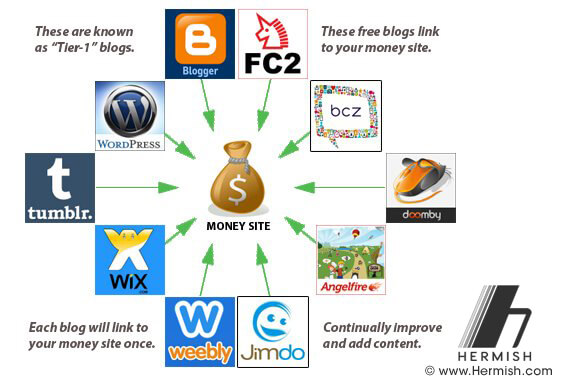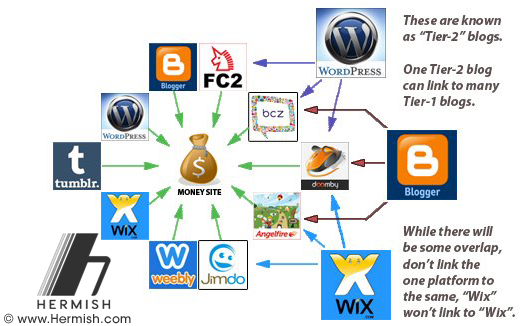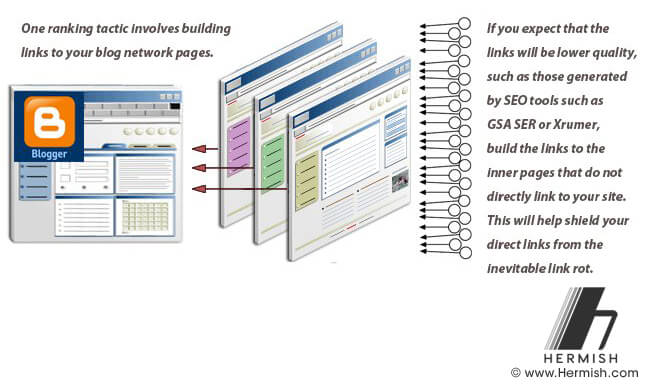How to Build Link Pyramids
Contents
The concept of a link pyramid is that you’ll have some blogs that directly link to your site. These are known as your “Tier-1”. Then, you’ll have more blogs that link to those blogs. Those are known as your “Tier-2”. You can continue the concept into infinity, with an ever-growing pyramid-shaped link network that continually builds the strength of your network, as it funnels link juice to your site.
Link Pyramid: Tier 1
The first image below illustrates this concept well. This is the arrangement that your Tier-1 might take.

The above example shows 10, however feel free to make as many tier-1 blogs as you can manage. It’s important to not bite off more than you can chew. Remember, you have to occasionally add posts to these free blogs. Whether it’s once per week, or once per month, you will be rewarded according to the effort you put into it.
While you won’t do this to the extent that you should be doing it for your money site, all the same on-page SEO best practices also apply to your 1st tier blogs. If you slowly improve your web2.0s, Google will realize that it is an actively managed blog and it will have more juice to flow to your site.
After you have created your first tier, to a size that is manageable, consider creating a second tier that links to the first. While it is expected that you won’t be maintaining this as actively as you maintain your money site and tier-1, continually adding content and improving these blogs will only make your tier-1 all that much more powerful.
Link Pyramid: Tier 2
Following is an image of what a 2nd tier of your blog network should look like. Note that one blog on tier 2 can link to multiple blogs on tier 1. While there will be a little overlapping, each blog should not have the exact same outlinking patterns. Throw a few outgoing authority links on each blog, that link out to different websites (not owned by you), that are credible and rank well in Google’s SERPs. Of course, you don’t want to promote a competitor. Good sites for this are government websites or .edu sites that have more information about the topic of your niche.

You’ll notice that you’re able to reuse the same platforms as you make your network larger. The image above shows Wix linking to Jimdo, Angelfire and Doomby, as a Tier-2 link. However, there’s also a Wix site on Tier-1. This works great, and allows you to leverage all of the dozens of free blogs to a large extent as you continually increase the size of your free blog link pyramid.
On the previous page of this free blog guide, I mentioned that you will only get one link per blog. Then, that blog will continue to receive even more pages of content, where those pages will have links in-content that lead back to the page that links to your money site. That can be a little difficult to visualize. Following, I created a graphic that shows how to do this in more detail.

Internal Linking on Tier 1 = Tier 2
In the above example, a blogger blog has seven total pages. One links to your money site, and six pages link to the page that links to your money site. For all intents and purposes, those six pages are tier 2 to your money blog. This is so much more of a powerful usage of free blogs than the entire SEO community typically does — that of building a one page web2.0 and then abandoning it. By using this concept, if you build 50 Tier-1 blogs, each with six pages functioning as a Tier-2, you in effect have built 50 Tier-1 and 300 Tier-2 links. You can see how this will increase exponentially when it comes time to build your 2nd Tier of free blogs!
Low Quality Links As Higher Tiers?
Lets talk about getting your free blogs links from outside the network you’re creating. I’m talking about the lower-quality links you would get from comment spam, wiki-links, and other lower quality web2.0 links that these tools can build, etc. On one hand, you could keep your network free from these types of links, that you could either build yourself or hire from Fiverr. Even that is a footprint, a group of web2.0s that only link to other web2.0s. Ideally, both your money site, and your blogs, will receive a wide variety of links, and not just links from other web2.0s.
These types of links have their place, but on the other hand you want to keep them away from your main website. Why? The main reason these types of links, built with SEO tools, are bad is because of link rot. Those links won’t always be there. For instance, comment spam — any website that allows comment spam will get a deluge of hundreds of comment spams per day. Eventually, that website will disappear, or the comments will get pushed to an un-spidered page 2 of comments. In effect, the comment will be no longer available for Google to spider. That will be registered as link rot, and it will affect your rankings (assuming the links are directly to your main website).
We don’t want those links directly to our money sites. We also, preferably, don’t want them on our Tier-1. What can we do about this? Remember we were discussing how, on your free blogs, they have these additional pages that link a main page on the free blog? Instead of creating lower quality links directly to the page that links to your money site, we will create links to the inner pages. This will make them stronger, and when the link rot starts happening, that link rot is at minimum 2 links away from your money site. Below is an image which better explains how this works.

You may begin to feel a little overwhelmed when it comes to updating so many blogs. There is an excellent SEO Tool that will help you manage this better. It is called FCS Networker, and not only will it help you post to free blogs, it can even post to your own hosted private blog network created from WordPress blogs. You can use this software to schedule posts to your blog network, and it makes things much easier. Continue reading to learn all about it!

Comments